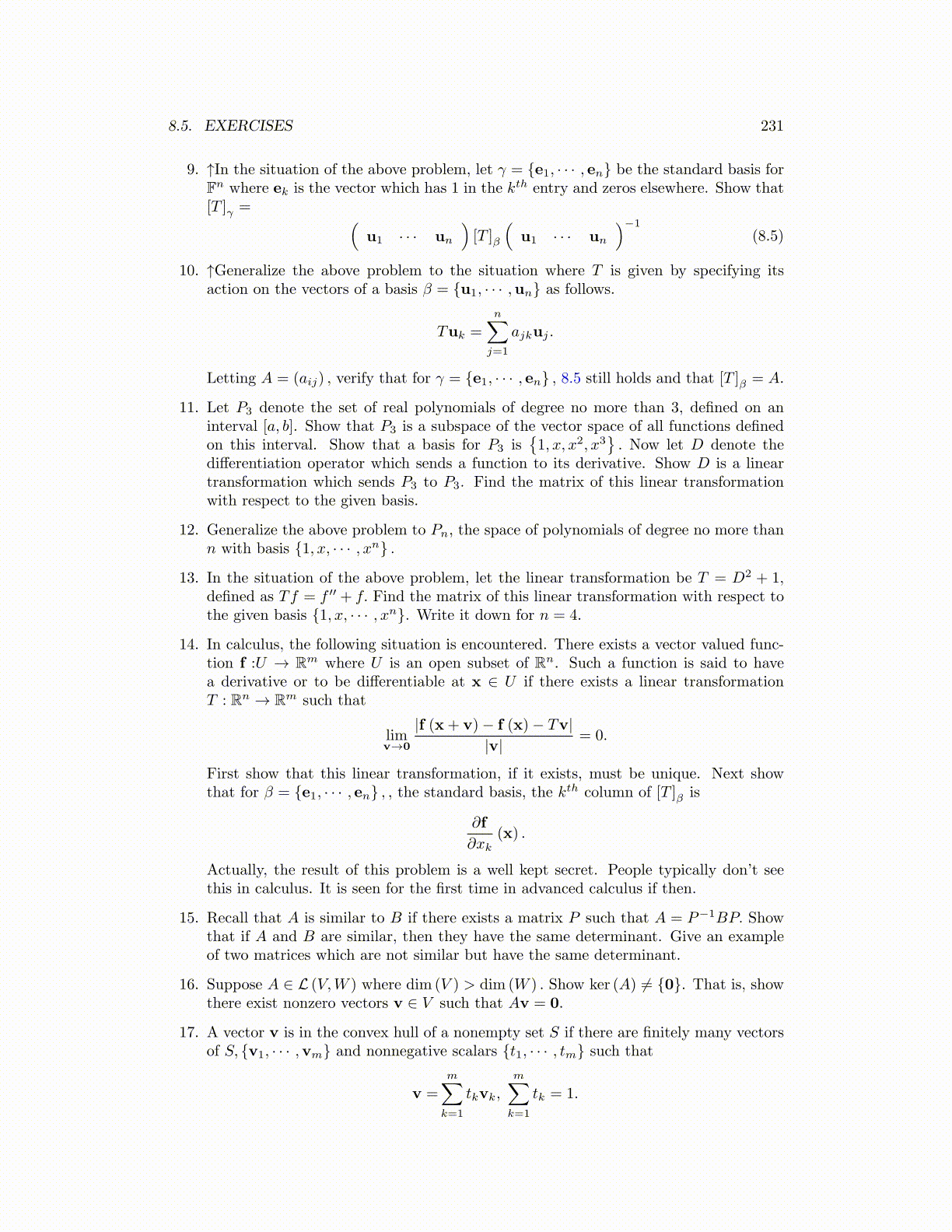
8.5. EXERCISES 231
9. ↑In the situation of the above problem, let γ = {e1, · · · , en} be the standard basis forFn where ek is the vector which has 1 in the kth entry and zeros elsewhere. Show that[T ]γ = (
u1 · · · un
)[T ]β
(u1 · · · un
)−1
(8.5)
10. ↑Generalize the above problem to the situation where T is given by specifying itsaction on the vectors of a basis β = {u1, · · · ,un} as follows.
Tuk =
n∑j=1
ajkuj .
Letting A = (aij) , verify that for γ = {e1, · · · , en} , 8.5 still holds and that [T ]β = A.
11. Let P3 denote the set of real polynomials of degree no more than 3, defined on aninterval [a, b]. Show that P3 is a subspace of the vector space of all functions definedon this interval. Show that a basis for P3 is
{1, x, x2, x3
}. Now let D denote the
differentiation operator which sends a function to its derivative. Show D is a lineartransformation which sends P3 to P3. Find the matrix of this linear transformationwith respect to the given basis.
12. Generalize the above problem to Pn, the space of polynomials of degree no more thann with basis {1, x, · · · , xn} .
13. In the situation of the above problem, let the linear transformation be T = D2 + 1,defined as Tf = f ′′ + f. Find the matrix of this linear transformation with respect tothe given basis {1, x, · · · , xn}. Write it down for n = 4.
14. In calculus, the following situation is encountered. There exists a vector valued func-tion f :U → Rm where U is an open subset of Rn. Such a function is said to havea derivative or to be differentiable at x ∈ U if there exists a linear transformationT : Rn → Rm such that
limv→0
|f (x+ v)− f (x)− Tv||v|
= 0.
First show that this linear transformation, if it exists, must be unique. Next showthat for β = {e1, · · · , en} , , the standard basis, the kth column of [T ]β is
∂f
∂xk(x) .
Actually, the result of this problem is a well kept secret. People typically don’t seethis in calculus. It is seen for the first time in advanced calculus if then.
15. Recall that A is similar to B if there exists a matrix P such that A = P−1BP. Showthat if A and B are similar, then they have the same determinant. Give an exampleof two matrices which are not similar but have the same determinant.
16. Suppose A ∈ L (V,W ) where dim (V ) > dim (W ) . Show ker (A) ̸= {0}. That is, showthere exist nonzero vectors v ∈ V such that Av = 0.
17. A vector v is in the convex hull of a nonempty set S if there are finitely many vectorsof S, {v1, · · · ,vm} and nonnegative scalars {t1, · · · , tm} such that
v =
m∑k=1
tkvk,
m∑k=1
tk = 1.